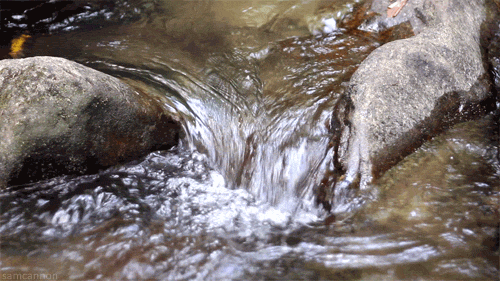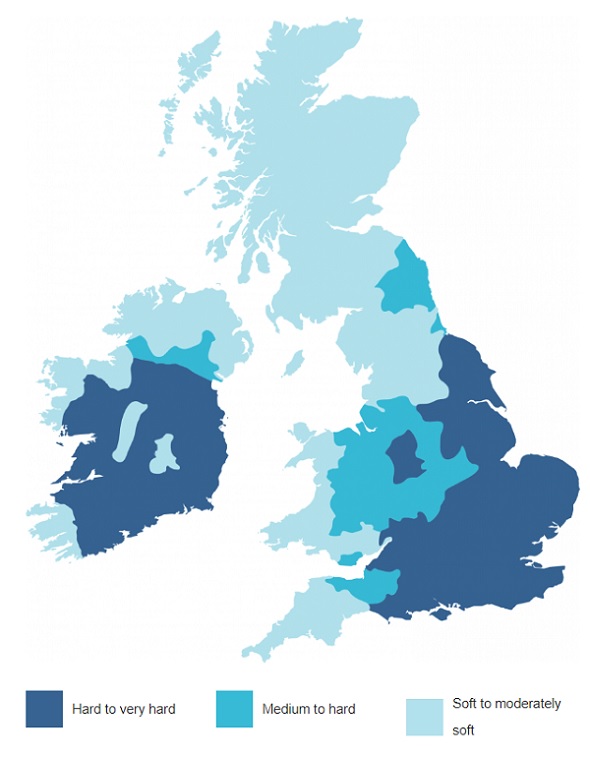Not all water is equal, and when it comes to using water in a steam iron or steam generator iron, you want two things; water that converts to steam easily, and water that doesn’t cause a build-up of limescale.
You might be asking yourself:
“Is plain tap water suitable for a steam iron?”
“Or do I need distilled water?”
Well, here’s the answer – it depends on the mineral content of your tap water. If you’re living in a soft water area, then tap water will be ideal. However, if you live in a hard water zone, then you’ll need to include a mixture of distilled or demineralised water at a 50/50 ratio.
Soft vs Hard Water

Hard water: The mineral concentration, rather than the water’s rigidity, is what gives hard water its name.
Rainwater, on its way through the water cycle and into our homes, absorbs minerals from rocks like chalk and limestone. Water becomes hard if the minerals picked up are primarily calcium and magnesium.
Hard water affects roughly 60 per cent of British households. These homes are mostly found in the central, eastern, and southern parts of the country.
Drinking hard water is not harmful to the body. In fact, these minerals are said to have some health properties. But it can damage appliances – like steam irons, for example, because of the tartar-like limescale coating it leaves behind.
Soft water: The term “soft water” refers to water that has a negligible amount of minerals. Water from rain, for instance, has a gentler pH and is naturally soft. Since there are no minerals for it to gather up as water seeps through the hard, impermeable rock layers, it keeps its suppleness. This is why some rainy regions of the UK enjoy the benefits of naturally soft water.
Only in cases where the local water supply is excessively hard should distilled or demineralized water be used in your iron. While it’s true that demineralized water prevents the build-ups of scale, the acidity it contains may be harmful to the iron’s circuitry and any stainless steel descaling components.
Preventative anti-scale technologies are standard on most premium steam irons and steam generators. In some irons, additional features include an anti-limescale rod to gather deposits or a self-cleaning mechanism that generates a heat shock to get rid of any leftover debris.
Generally, manufacturers suggest using 50% tap water and 50% demineralized water if the water from the tap is still too calcareous – regardless of your iron’s anti-cal functions for water hardness greater than 200 parts per million (200PPM).
Not sure if your home has hard, minimum, or soft water? Have a look at this water hardness map of the UK as a guide:

Distilled or Demineralised Water for Ironing
Despite their similarities, distillation and demineralization use very dissimilar processes to remove minerals from water.
Distilled water is just water that has been subjected to a procedure in which it is heated to a temperature over its boiling point, the steam generated from this process is collected, and the resulting water is cooled to make a liquid. Using this approach, which is by far the most popular, yields extremely pure water.
Demineralised water is water from which the minerals have been stripped. Calcium, sulphate, chloride, magnesium, and sodium are removed by means of ion-exchange, or electro-deionization. These techniques all aim to remove magnetically charged ions from the mixture.
Both types of water are suitable for use in a steam iron and generator, but distilled water has the edge.
It’s good practice you add some distilled, or demineralised water (sometimes call de-ionised) to the water going into your steam iron – regardless of hardness. If you live in Scotland, Wales, Northern Ireland, or anywhere else in the UK with predominantly very soft tap water, you can include 30% distilled water with 70% tap water.
If you’re unfortunate enough to live where the tap water is “hard”, then a higher concentrated mix of distilled and tap water at 50/50 is essential, otherwise, your iron soleplate will quickly develop a white chalky build-up of limescale.
This is caused by the high levels of minerals in the water, namely magnesium and calcium. When hard water evaporates during the ironing process, calcium and magnesium are left behind and cause calcified limescale.
The limescale can damage any appliance that uses water – from showers to coffee machines, and in the case of steam irons and generators, this calcification of limescale can block steam nozzles, preventing steam from escaping, and reduces your irons ability to heat water effectively.
Best Type of Water for Steam Irons and Generators
- Have soft water in your home? – tap water is fine. But if you want to increase the lifespan of your iron, dilute it with 30% distilled water.
- Have hard water in your home? – use a mix of 50% tap water and 50% distilled water, avoiding bottled, fragranced, or any other type of water.
It’s that simple. This formula will reduce the chance of limescale deposits, maintaining optimal heat performance and avoiding the chance of discoloured brown water leaks from your iron, drips, and spitting, and will help keep steam nozzles on the soleplate unclogged.
You should never fill your irons’ tank with scented water, bottled mineral water, tumble dryer condenser water (you know who you are), or refrigerator defrosted ice since all of these sources of water include contaminants that could compromise the finished product.
When compared to demineralized water, softened water simply removes excess calcium and magnesium, hence many manufacturers recommend against using it.
Also, if you buy “ironing water”, make sure to read the label, because a lot of their liquid products are designed to be sprayed from a separate spray bottle, and not to be poured into the irons water tank.
If you want to jazz up the smell of your fresh laundry when ironing, use a fragranced mist spray, and avoid the temptation to put any kind of fragrance fluids or additives into the water tank. And no, you can’t pour a cheeky bit of Zoflora into the water, as this is not suitable for use in any electrical appliance.
Distilled water is the preferred choice, with demineralised at a close second.



